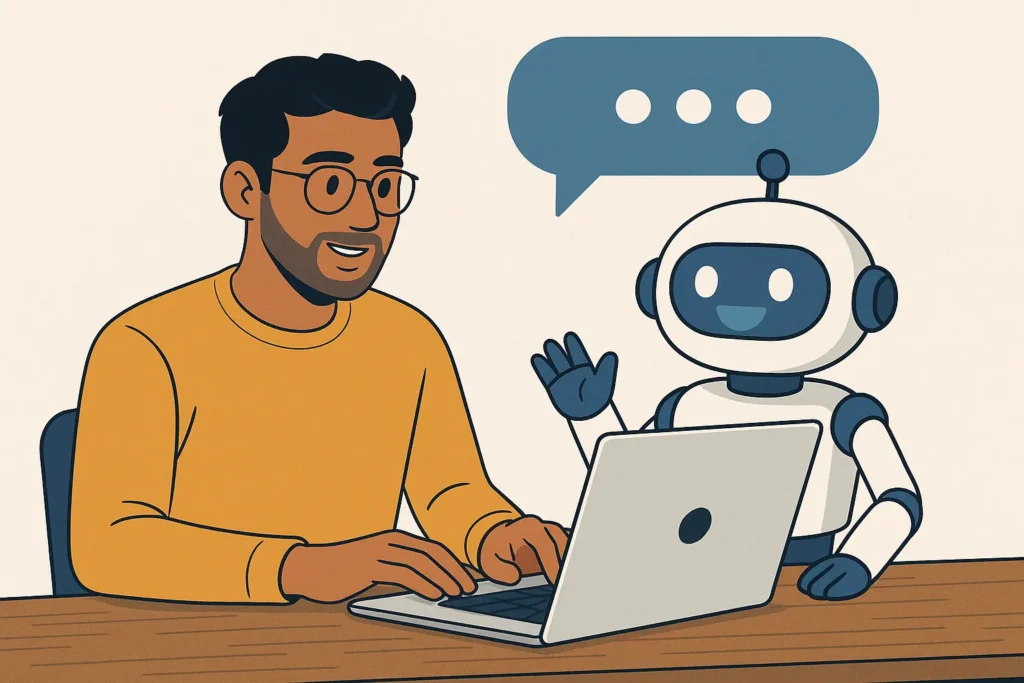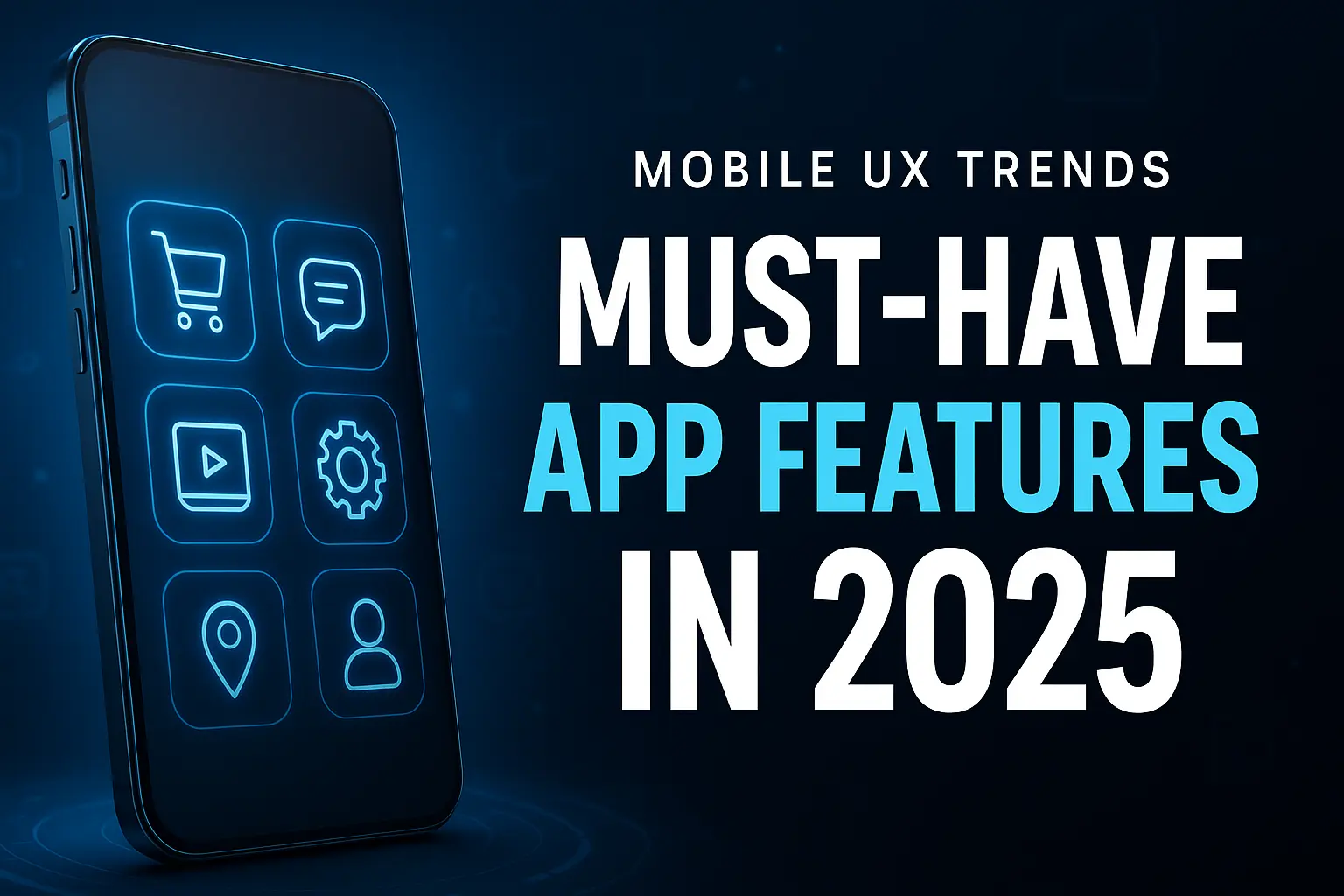By Junaid Imdad, Blogger & Digital Experience Strategist
Remember when simply having a mobile app was enough to grab attention? Those days are long behind us.
Welcome to 2025, where mobile app users are looking for so much more than just smooth performance—they want speed, intelligence, personalization, and a little bit of that wow-factor. In this fast-changing world of mobile app features, it’s not enough to create an app that merely works; you need to craft one that delights users, tackles real problems, and leaves a lasting impression from the very first tap.
Today’s users are tech-savvy, impatient, and quick to hit that uninstall button on apps that don’t provide instant value. This means that the most successful apps are those that blend cutting-edge features—like AI-driven personalization, seamless syncing across devices, voice interaction, and real-time support—with experiences that feel human-centered and effortless.
If you’re in the process of building, updating, or scaling an app in 2025, your strategy should go beyond just ticking off functional requirements. It’s about genuinely understanding what users want, anticipating their needs, and infusing innovation, empathy, and usability into every aspect of the user experience. Apps that achieve this aren’t just used—they’re cherished, shared, and kept around.
Having spent the last five years diving into digital strategy and user experience, I’ve witnessed how quickly user expectations evolve alongside technology. In this blog, we’ll dive into the essential mobile app features that 2025 users now consider non-negotiable, from seamless performance to hyper-personalization and smart automation.
Top Mobile App Features 2025 Users Expect by Default
In 2025, mobile app users are looking for so much more than just the basics—they want experiences that are seamless, smart, and tailored just for them. The features that users expect from mobile apps have shifted from being cool extras to essential must-haves. Think about AI-driven personalization that customizes content and user journeys in real time, or voice-enabled search that makes everything quicker and more accessible. Today’s users want apps that evolve with them, not the other way around.
Security is a top priority too, with biometric authentication—like facial recognition and fingerprint scanning—becoming the go-to method for quick and secure access. Plus, real-time data syncing across devices means users can hop between their phones, tablets, and desktops without missing a beat. And let’s not overlook offline functionality, which keeps users productive or entertained even when they’re not connected to the internet.
These features aren’t just “nice-to-haves” anymore—they’re absolutely essential. If your app can’t provide smooth performance, an intuitive user experience, and smart automation, users won’t hesitate to switch to competitors who can. As app stores get more crowded and user expectations continue to climb, it’s vital for developers, startups, and brands to keep up with these mobile app trends to stand out and keep their users coming back for more.
1. Hyper-Personalization: Not Just Their Name Anymore
A simple “Hi, Sarah!” no longer cuts it.
In 2025, users expect their apps to feel like they were designed just for them. That means personalization based on:
- Browsing behavior
- Purchase history
- Geo-location
- Time of day
- Even mood (yes, some apps detect this via AI or past behavior patterns)
Example: Imagine a fitness app that effortlessly shifts to dark mode for your evening workouts and plays soothing music when it detects you’re running low on energy, all based on how you typically use it.
The technology behind this—AI, machine learning, and behavioral analytics—is more accessible than ever. If your app is still treating every user the same, you’re already falling behind. To keep up with the competition, you need to embrace the mobile app features that users in 2025 will expect, such as real-time personalization, adaptive user interfaces, and smart recommendations that understand the context.

2. Voice and Gesture Control
With the growing popularity of voice assistants like Alexa, Siri, and Google Assistant, people have gotten used to chatting with their devices, and now they expect your app to do the same. Voice interaction has shifted from being a nice-to-have to a must-have, ranking high on the list of mobile app features that users will be looking for in 2025. Whether it’s through voice search, voice commands, or in-app voice navigation, this hands-free capability makes for quicker, more intuitive, and accessible user experiences.
Voice search, voice navigation, and even gesture-based interactions—especially in AR/VR apps—are rapidly becoming the norm for mobile app features that users will expect in 2025. These user-friendly features not only boost accessibility but also create a more seamless, immersive, and futuristic experience. As we look ahead to the essential mobile app features of 2025, it’s clear that user behavior is leaning towards more natural and hands-free interactions.
Take, for example, a food delivery app that allows users to reorder their last meal by simply saying, “Order my last Friday dinner,” or lets them scroll through menus with a wave of their hand in smart glasses. This perfectly showcases the kind of intuitive, intelligent, and hands-free mobile app features that users will come to expect in 2025.
This isn’t just a concept from a sci-fi movie anymore; it’s quickly becoming the norm.
3. Frictionless Payments and Digital Wallets
In 2025, we’re almost cashless. Most users want to complete purchases with:
- A fingerprint
- A face scan
- A single tap using Apple Pay, Google Pay, or regional digital wallets
If your checkout process in 2025 still requires users to manually input credit card numbers, billing addresses, or shipping details, you could be missing out on a significant amount of revenue. In the fast-moving world of mobile apps, every second matters—and any friction during checkout can seriously hurt your conversion rates.
By 2025, users expect modern mobile app features like autofill options, one-tap payments, and smooth integration with digital wallets such as Apple Pay, Google Pay, and PayPal. These features not only streamline the purchasing process but also foster trust by providing secure and hassle-free payment methods.
Today’s users are accustomed to apps that respect their time and eliminate unnecessary steps in their journey. If your checkout experience doesn’t meet this expectation for speed, convenience, and intuitive design, users won’t think twice about abandoning their carts and opting for a competitor that gets it right. To boost conversions and cultivate long-term loyalty, enhancing your payment flow with smart automation and a frictionless design isn’t just a nice-to-have—it’s absolutely crucial.
Bonus expectation: Buy Now, Pay Later (BNPL) options like Klarna and Afterpay have moved into app ecosystems. Giving users more control over how they pay is part of a better user experience.
4. Offline Functionality
Believe it or not, having internet access isn’t always a given, especially in areas with shaky connections or when you’re on the go. That’s why one of the most overlooked yet crucial features for mobile apps in 2025 is offline functionality.
Today’s smart apps are being crafted to tackle real-life hurdles like weak signals, limited data, or even total disconnection. Whether it’s a navigation app that provides offline maps, a note-taking app that syncs once you’re back online, or a food delivery app that keeps track of your recent orders, users now expect their go-to apps to function even when the internet is down. In the landscape of mobile app features that 2025 users are looking for, offline functionality has shifted from being a nice extra to a must-have for building trust and usability.
Adding an offline mode not only enhances the user experience but also fosters trust. People are much more inclined to stick with an app that delivers consistent performance, no matter the connectivity situation. As part of the essential mobile app features that users now demand in 2025, offline resilience has truly become a competitive edge—not just a luxury.
Whether it’s a travel app that saves boarding passes offline or a productivity tool that lets users jot down notes without Wi-Fi, offline access brings significant value.
Your app doesn’t need to be fully operational without the internet, but it should be functional enough to keep users productive and stress-free when the signal drops.
5. AI-Powered Customer Support (That Feels Human)
Chatbots have evolved beyond being just a passing trend—they’re now essential features in mobile apps for 2025. However, there’s a twist: users are growing weary of robotic responses and the frustrating “Let me connect you to someone” routine. In the current mobile landscape, people crave instant, smart, and genuinely human-like interactions instead of clunky automation.
Thanks to significant strides in GPT-style AI and advanced Natural Language Processing (NLP), today’s chatbots can engage in conversations that feel personal, empathetic, and truly useful. These AI-powered assistants can tackle everything from troubleshooting problems to offering tailored recommendations—all in real time, without making users feel like they’re chatting with a machine.
This transformation in chatbot technology signals a significant change in what users expect. As we look ahead to the must-have mobile app features of 2025, intelligent chatbots not only boost user satisfaction but also help cut support costs and improve retention. In a nutshell, if your app doesn’t provide smart, conversational support, you’re missing out on a powerful opportunity to build trust and deliver an exceptional customer experience.
Pro tip: Let the AI handle common queries, but make escalation to a human support agent seamless. No one wants to “press 5” to talk to someone anymore.

6. Eco-Friendly & Battery-Efficient Design
Sustainability is a big deal for users in 2025. In 2025, people are more conscious than ever about how apps impact their device performance and the environment. They’re really paying attention to which apps drain their battery, use up too much mobile data, or run unnecessary background processes.
App stores like Google Play and the Apple App Store have started highlighting energy-hungry apps and showcasing those that are designed to be more efficient with battery and data. Many even sport “eco-friendly” badges or power usage scores that help users make informed choices before hitting that download button.
Today’s users are looking for mobile apps that not only work well but also take care of their device’s resources. Developers who focus on optimizing battery life, background processing, and eco-friendly practices will definitely stand out by providing responsible, user-friendly experiences.
As sustainability becomes a key principle in technology, energy-efficient design is no longer just a nice-to-have—it’s one of the essential features of mobile apps in 2025.
Developers are optimizing:
- Battery use
- CPU cycles
- Dark mode (not just aesthetic, it actually saves battery on OLED screens)
Sustainability isn’t just good PR; it’s a feature.
7. Built-In Privacy and Data Transparency
After years of scandals and overreach, today’s users are more privacy-aware than ever.
Apps in 2025 must:
- Clearly explain what data is being collected and why
- Offer easy opt-outs or customization of permissions
- Avoid tracking without consent
In 2025, transparency is no longer just a nice-to-have—it’s a must. Users are coming to expect mobile apps to provide user-friendly privacy control dashboards, where they can effortlessly manage permissions, check data access logs, and tweak settings on the fly. These dashboards empower users, giving them a sense of control and ownership over their digital presence, which is quickly becoming a major selling point.
As we look at the essential features for mobile apps in 2025, embedding trust into the user experience is crucial for keeping users engaged. People are much more inclined to stick with apps that are clear about what data they gather, how it’s utilized, and how users can manage it. By focusing on privacy, clarity around permissions, and transparency, brands not only comply with regulations—they also build user loyalty.
In today’s world, trust isn’t just a value—it’s a competitive edge. If your app lacks straightforward privacy tools, users will likely seek out alternatives that do.
8. Real-Time Sync Across Devices
Whether it’s continuing a task from smartphone to tablet to desktop or syncing data instantly across platforms, users expect uninterrupted, real-time access.
A to-do app that doesn’t sync instantly across devices? Forget it.
In 2025, cross-device syncing is table stakes, not a luxury.
9. Micro-Interactions and Delightful UX
Today’s users aren’t just looking for apps that function well—they want them to be enjoyable to use. It’s not enough for an app to simply work; it has to provide a smooth, intuitive, and emotionally rewarding experience.
This is where micro-interactions come into play. These are the little, often unnoticed moments that bring joy—like a gentle bounce when you refresh a page, a satisfying buzz when you finish a task, or a button that lights up instantly with visual feedback. When executed well, these small details make your app feel more responsive, human, and engaging.
By 2025, these polished elements won’t just be nice-to-haves—they’ll be essential features that users expect from mobile apps. Micro-interactions now play a crucial role in:
- Guide users
- Reward actions
- Communicate system status (like a swipe to refresh animation)
Apps that feel clunky or flat are increasingly abandoned for ones that feel alive and polished.
10. AR Capabilities and Immersive Design
Augmented reality (AR) is no longer reserved for gaming. In 2025, it’s part of:
- Virtual try-ons for fashion or makeup
- AR furniture placement
- Onboarding tutorials with 3D walkthroughs
Even if your app isn’t meant to be a fully immersive experience, adding some AR-lite features—like interactive overlays, real-world filters, or virtual try-ons—can really enhance user engagement and keep them coming back. These simple augmented reality tweaks add a fun layer of interactivity that feels fresh and exciting, all without the need for heavy development or putting too much strain on devices.
By 2025, users are going to be looking for those experiential moments in their apps. Even the smallest AR features can transform ordinary interactions into memorable brand experiences, helping your app shine in a sea of competition.
Final Thought: Building for Human Expectations
If there’s one theme that connects all of these features, it’s this: users expect their apps to understand and support them as humans.
They want apps that:
- Predict their needs
- Respect their privacy
- Save them time
- Provide value instantly
- Feel great to use
Apps have transformed from mere tools into our companions, personal assistants, and even sources of entertainment. By 2025, users won’t just be opening apps to “get things done.” They’ll expect these apps to anticipate their needs, adapt to their habits, and blend effortlessly into their everyday routines.
As a digital strategist, I’ve witnessed how businesses can achieve remarkable success by focusing on user experience. The companies that thrive are the ones that truly listen to user feedback, eliminate any obstacles in the experience, and design with empathy in mind. When brands prioritize what people genuinely need—rather than just chasing trends—they foster stronger engagement, deeper loyalty, and better retention rates.
The future is bright for brands that recognize: an app is no longer just software; it’s a relationship.
Want info about UI/UX trends, click on it.

So if you’re building or refining your mobile app in 2025, remember: features don’t just make your app better, they shape the emotional connection users have with your brand.
Have you noticed any of these features in your favorite apps recently? What features do you expect as a user? Share your thoughts in the comments or connect with me, I’d love to hear how your app experience has evolved.
Junaid Imdad, Blogger & Digital Experience Strategist
Let’s talk about apps and user experience on LinkedIn.




Avoid These 10 Common Business Website Mistakes in 2025 - Devitcity
[…] to know how much it will Top Mobile App Features in 2025, click on […]